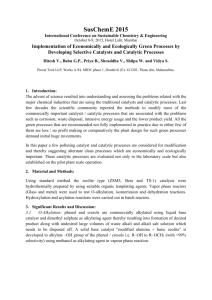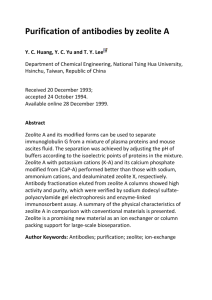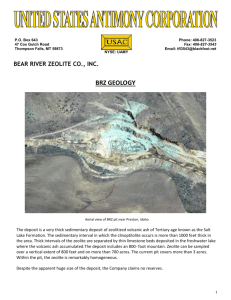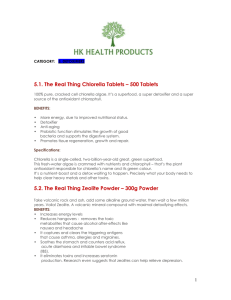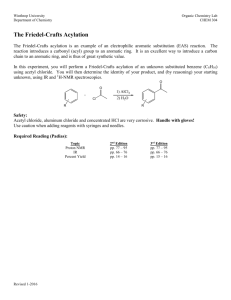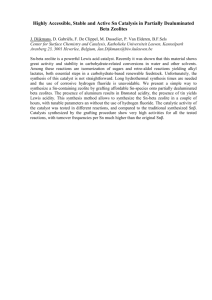FRIEDEL-CRAFTS ACYLATION OF ANISOLE CATALYSED BY
advertisement
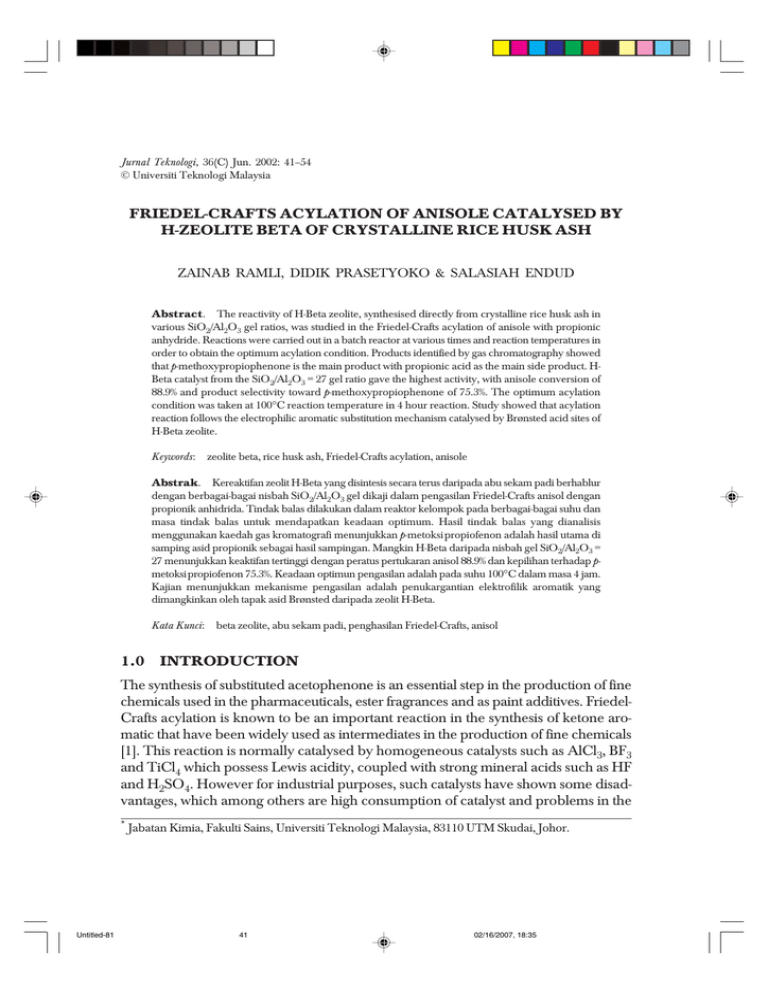
FRIEDEL-CRAFTS ACYLATION OF ANISOLE CATALYSED 41 Jurnal Teknologi, 36(C) Jun. 2002: 41–54 © Universiti Teknologi Malaysia FRIEDEL-CRAFTS ACYLATION OF ANISOLE CATALYSED BY H-ZEOLITE BETA OF CRYSTALLINE RICE HUSK ASH ZAINAB RAMLI, DIDIK PRASETYOKO & SALASIAH ENDUD Abstract. The reactivity of H-Beta zeolite, synthesised directly from crystalline rice husk ash in various SiO2/Al2O3 gel ratios, was studied in the Friedel-Crafts acylation of anisole with propionic anhydride. Reactions were carried out in a batch reactor at various times and reaction temperatures in order to obtain the optimum acylation condition. Products identified by gas chromatography showed that p-methoxypropiophenone is the main product with propionic acid as the main side product. HBeta catalyst from the SiO2/Al2O3 = 27 gel ratio gave the highest activity, with anisole conversion of 88.9% and product selectivity toward p-methoxypropiophenone of 75.3%. The optimum acylation condition was taken at 100°C reaction temperature in 4 hour reaction. Study showed that acylation reaction follows the electrophilic aromatic substitution mechanism catalysed by Brønsted acid sites of H-Beta zeolite. Keywords: zeolite beta, rice husk ash, Friedel-Crafts acylation, anisole Abstrak. Kereaktifan zeolit H-Beta yang disintesis secara terus daripada abu sekam padi berhablur dengan berbagai-bagai nisbah SiO2/Al2O3 gel dikaji dalam pengasilan Friedel-Crafts anisol dengan propionik anhidrida. Tindak balas dilakukan dalam reaktor kelompok pada berbagai-bagai suhu dan masa tindak balas untuk mendapatkan keadaan optimum. Hasil tindak balas yang dianalisis menggunakan kaedah gas kromatografi menunjukkan p-metoksi propiofenon adalah hasil utama di samping asid propionik sebagai hasil sampingan. Mangkin H-Beta daripada nisbah gel SiO2/Al2O3 = 27 menunjukkan keaktifan tertinggi dengan peratus pertukaran anisol 88.9% dan kepilihan terhadap pmetoksi propiofenon 75.3%. Keadaan optimun pengasilan adalah pada suhu 100°C dalam masa 4 jam. Kajian menunjukkan mekanisme pengasilan adalah penukargantian elektrofilik aromatik yang dimangkinkan oleh tapak asid Brønsted daripada zeolit H-Beta. Kata Kunci: beta zeolite, abu sekam padi, penghasilan Friedel-Crafts, anisol 1.0 INTRODUCTION The synthesis of substituted acetophenone is an essential step in the production of fine chemicals used in the pharmaceuticals, ester fragrances and as paint additives. FriedelCrafts acylation is known to be an important reaction in the synthesis of ketone aromatic that have been widely used as intermediates in the production of fine chemicals [1]. This reaction is normally catalysed by homogeneous catalysts such as AlCl3, BF3 and TiCl4 which possess Lewis acidity, coupled with strong mineral acids such as HF and H2SO4. However for industrial purposes, such catalysts have shown some disadvantages, which among others are high consumption of catalyst and problems in the * Untitled-81 Jabatan Kimia, Fakulti Sains, Universiti Teknologi Malaysia, 83110 UTM Skudai, Johor. 41 02/16/2007, 18:35 42 ZAINAB RAMLI, DIDIK PRASETYOKO & SALASIAH ENDUD separation step due to similar phases of the reaction products to that of the catalyst. In addition, the use of acidic reagents in aqueous form also create environmental problems such as corrosion. Heterogeneous catalyst has been given much attention to overcome the problems. Solid catalysts such as zeolites [2-13], phosphotungstic acid (H3PW12O40) supported on SiO2 in the form of cerium salt [13], mesoporous molecular sieves such as MCM-41 [14] and clay such as montmorillolite [15] are among the solid acid catalysts that have been used in Friedel-Crafts acylation. Recently, super acid solids was reported to be another type of heterogeneous catalyst used in the acylation of toluene with benzoyl chloride and benzoic anhydride [16]. The potential use of zeolite as catalyst in the Friedel-Crafts acylation is due to its acidity and shape selective characteristics. Aromatic acylation was studied using hydrogen form and modified zeolite Y, mordenite, beta, and ZSM-12 catalysts. Chiche et al. [8] studied the acylation of toluene and p-xylene by carboxylic acids catalysed by CeNa-Y zeolite in which they observed that the yield up to 94% of para isomer was produced. On the other hand the yield of the acylated p-xylene was found to be inversely proportional to the length of carbon chain of the acylated reagent used in the reaction. The electrophilic acylation of anisole (methoxybenzene) with phenyl acetate and phenyl propionic, phenylacetyl chloride, phenylpropionyl chloride [10] acetyl chloride [7] and acetic anhydride [2,4,6] have also been reported. Freese et al. [2] made a comparison of the activity and selectivity of zeolite H-Beta, H-Y, NH4-Y and H-ZSM-5 catalysts in the acylation of anisole by acetic anhydride. It was observed that H-ZSM5 showed lower activity than H-Y and H-Beta catalysts, due to smaller intersection channel in ZSM-5 compared to aromatic intermediate of Wheland type. Zeolite HBeta produced more than 99% para-methoxyacetophenone with very low ortho isomer, while the activity of H-Y depends on the Si/Al ratio of the catalyst [4,7]. Zeolite H-Beta has proven to be a reactive catalyst in many organic processes such as alkylation, acylation and various hydrocarbons reactions [2-5,17,18]. Its activity owes to its large pore type, high Si/Al ratio, high acid strength and thermal stability [19,20]. In this paper, the activity of zeolite H-Beta catalyst which was synthesised by direct usage of crystalline rice husk ash at different SiO2/Al2O3 gel ratios was studied on the acylation of anisole by using propionic anhydride. The study includes the optimisation of the reaction conditions as well as proposed reaction mechanism of the reaction that is closely related to the acidity of the zeolite. 2.0 EXPERIMENTAL 2.1 Preparation of the H-Beta Catalyst Zeolite beta was prepared according to the preparation method in reference [21], by using crystalline rice husk ash obtained from the field as a silica source. Pure zeolite Untitled-81 42 02/16/2007, 18:35 FRIEDEL-CRAFTS ACYLATION OF ANISOLE CATALYSED 43 beta in sodium form, Na-Beta was obtained from initial reaction mixtures in various SiO2/Al2O3 ratios of 15 – 90; using tetraethylammonium ions as organic template which also acted as a structure directing agent. The as-synthesised zeolite Na-Beta was changed to hydrogen form by NH4+ exchanged, followed by calcination at 400°C for at least 2 hours. The resulting samples in the hydrogen form were generally denoted as H-Beta. Samples were designated as H-Si-15, H-Si-20, H-Si-27, H-Si-45 and H-Si-90 (numerical 15, 20. 27, 45, and 90 were referred to the initial SiO2/Al2O3 ratio of the gel). 2.2 Acylation Reaction of Anisole by Propionic Anhydride Sample H-BEA (0.5 g) was activated at 500°C for 3 hours in air prior to the reaction. The acylation of anisole (3.30g, 30 mmol, 99% purity, Merck) by propionic anhydride (4.02 g, 30 mmol, 99% purity, Fluka Chimika) was performed at 100°C in a batch reactor with stirring. The liquid product was syringed out at the interval time of 0, 0.25, 0.5, 1, 2, 3, 4, 20 and 24 hours in order to determine the equilibrium of the reaction. The effect of reaction temperature was studied by varying the temperature at 50, 60, 100, 120 and 150°C with other parameters kept constant. The liquid product was analysed by gas chromatography (GC) of Hewlett Packard 5890 series II with FID detector using Phase AT-WAX column (diameter 0.25 mm, thickness 0.2 mm and length 30 m). About 0.1 mL sample was injected into the GC at the initial temperature of 50°C for 1 min, followed by increasing the temperature at the rate of 8°C/min to the final temperature of 200°C where it was held for 35 min. For each sample, the analysis was carried out three times in order to ensure reproducibility. Standard compound of p-methoxypropiophenone (> 99% purity, Aldrich Chemical) was used to identify the main product. 3.0 RESULTS AND DISCUSSION GC chromatogram of the liquid product from the reaction of anisole with propionic anhydride over zeolite H-Si-90 sample is presented in Figure 1, which shows 10 peaks. All products from other H-Beta samples gave identical chromatograms, indicating that similar compounds were produced from each sample. The first 2 initial peaks correspond to the reactants, i.e. anisole and propionic anhydride respectively, while the rest of the peaks belong to the products of the reaction. The major products were identified as p-methoxypropiophenone and propionic acid, which was in line with the theory of the reaction. The main products with the highest percentage component was identified as p-methoxypropiophenone, with 36.9 – 56.9% of the total components, followed by propionic acid between 15.4 – 22.5% while the rest of the peaks (not identified) gave less than 5% of the total area. In general the isomer selectivity of FriedelCrafts acylation products i.e. para to (meta + ortho) was 31: 1. The peaks of other isomers are expected to be very closed to each other due to similar physical and Untitled-81 43 02/16/2007, 18:35 44 ZAINAB RAMLI, DIDIK PRASETYOKO & SALASIAH ENDUD * anisole anisole propionic propionic anhydride anhydride * p-methoxypropiophenone p-methoxypropiophenone propionic propionic acid acid * * * Not Notidentified identified * * Retention time Retention time Figure 1 GC chromatogram of the acylation products catalysed by H-BEA chemical properties of the isomers. However, since only single peak was observed in the chromatogram which related to p-methoxypropiophenone, it was then concluded that only para isomer was formed from the reaction, hence the selectivity of the para isomer is 100%. The results showed the shape selective characteristic of zeolite beta towards para isomer rather than other isomers due to its smaller molecular sizes compared to its counterpart ortho or meta isomers. Previous study has also shown the selectivity of zeolites catalysts towards para isomer for many aromatic acylations [8,9]. Among the products, propionic acid is the main side product obtained in high yield from the reaction as expected from the reaction theory. Gaare and Akporiaye [7] and Smith et al. [4] reported that acetic acid was the main side product in the acylation of anisole with acetyl chloride and acetic anhydride using zeolite Y and beta as catalysts. Corma et al. [10] found phenylacetic acid as a side product in the acylation of anisole with phenyl chloride. Since propionic acid can also be the source of acyl, it may influence the reaction products. It was reported that acylation of toluene and pxylene with propionic acid catalysed by zeolite Y produced about 6% of para acylated product [8]. 3.1 Influence of Initial SiO2/Al2O3 Gel Ratio of Zeolite Beta Acylation of anisole by propionic anhydride using H-BEA catalyst in different SiO2/ Al2O3 ratios were performed to investigate the influence of SiO2/Al2O3 ratio of the Untitled-81 44 02/16/2007, 18:35 FRIEDEL-CRAFTS ACYLATION OF ANISOLE CATALYSED 45 catalysts towards products formed. Table 1 shows the percentage of products based on the peak area of the components. Figure 2 shows the relation between anisole conversion and p-methoxypropiophenone selectivity with SiO2/Al2O3 ratios of the HBeta catalysts. It was clearly shown that anisole conversion and pmethoxypropiophenone selectivity favoured zeolite beta obtained from higher SiO2/ Al2O3 gel ratios. However, results also indicated an optimum H-Beta with SiO2/Al2O3 gel ratio of 27, gave the highest conversion and selectivity. Since higher SiO2/Al2O3 gel ratio usually produced zeolite with higher Si/Al ratio of zeolite framework, it can also be suggested that the anisole conversion and product selectivity favoured higher Si/Al ratio of zeolite beta. Table 1 Percentage of components in the acylation of anisole with propionic anhydride catalysed by H-Beta zeolite with different SiO2/Al2O3 Products, % components Component H-Si-15 H-Si-20 36.8 25.8 7.3 3.9 Propionic acid 16.0 p-Methoxy-propiophenone Anisole Propionic anhydride Not identified H-Si-27 H-Si-45 H-Si-90 27.1 27.1 0.3 2.4 5.6 17.0 22.5 20.6 15.4 36.9 49.5 56.8 46.3 47.8 2.9 3.8 3.7 3.5 4.2 17 100 % component 90 Anisole conversion 80 p-methoxypropiophenone selectivity 70 60 50 0 20 40 60 80 100 SiO2/Al2O3 initial gel ration Figure 2 Untitled-81 Influence of SiO2/Al2O3 gel ratio of the H-Beta catalyst towards conversion and product selectivity 45 02/16/2007, 18:35 46 ZAINAB RAMLI, DIDIK PRASETYOKO & SALASIAH ENDUD 3.2 Influence of Reaction Time The influence of reaction time was studied using sample H-Si-20 (SiO2/Al2O3=20) for the duration between 0 to 24 hours. Figure 3 shows the change of concentration of anisole, p-methoxypropiophenone and propionic acid versus reaction time. In general, the concentration of anisole was found to decrease significantly in the first 2 hours of the reaction, followed by a slow decreased as the time of reaction increased. In parallel with the decrease of anisole, the concentration of p-methoxypropiophenone increased sharply in 2 hours and rose slowly until it reached equilibrium after about 5 hour reaction. The trend of concentration changes of propionic acid was similar to that of p-methoxypropiophenone, having lower magnitude and reaching equilibrium in about 3 hours reaction. % component 80 60 Propionic acid p-methoxypropiophenone 40 Anisole 20 0 0 5 10 15 20 25 Reaction time, h Figure 3 Influence of reaction time to products concentration Chiche et al. [8] in the acylation of toluene and p-xylene with various carboxylic acids catalysed by zeolite, reported that propionic acid can also be used as acylation agent. As propionic acid was the main side product of the acylation of anisole with propionic anhydride, it was suspected that this compound might take part in the reaction as acylation agent. However, results showed that there was no obvious decline in the concentration of propionic acid with time of reaction, suggesting that propionic acid did not act as an acylation agent in this reaction. It was further supported from Figure 4, which show an increase of propionic acid concentration with time, which was parallel with the increase concentration of p-methoxypropiophenone. Untitled-81 46 02/16/2007, 18:35 FRIEDEL-CRAFTS ACYLATION OF ANISOLE CATALYSED 47 p-methoxypropiophenone, % component 80 60 40 20 0 0 5 10 15 20 25 Propionic acid, % component Figure 4 Concentration of propionic acid vs. p-methoxypropiophenone 100 % component 80 60 Anisole conversion anisol yang bertindak balas 40 kepilihan 4-metoksipropiofenon p-methoxypropiophenone selectivity 20 0 0 5 10 15 20 25 Reaction time, h Figure 5 Conversion of anisole and p-methoxypropiophenone as a function of reaction time Figure 5 represents the anisole conversion and p-methoxypropiophenone selectivity with time of reaction. It is observed that the conversion of anisole increased sharply in the first 2 hours of the reaction before reaching equilibrium, while selectivity of pmethoxypropiophenone took only 1 hour to reach equilibrium. Based on the results obtained in this reaction, the optimum reaction time for the acylation of anisole with propionic anhydride was taken as 4 hours. Untitled-81 47 02/16/2007, 18:35 48 ZAINAB RAMLI, DIDIK PRASETYOKO & SALASIAH ENDUD 3.3 Influence of Reaction Temperature The influence of reaction temperature in the anisole conversion was studied using HSi-20 sample at different temperature between 50 – 150°C. Anisole conversion and pmethoxypropiophenone selectivity at different reaction temperatures were shown in Figure 6. It was observed that the conversion of anisole and the selectivity of pmethoxypropiophenone increased with the increase of reaction temperature without having an optimum at the range of the temperatures studied. It indicated that the activity of H-Beta catalysts increased with the increase of reaction temperature, suggesting an endothermic process. At low temperature (50°C), the selectivity of the zeolite catalyst towards p-methoxypropiophenone is about 25.6%. When the temperature was increased two-fold to 100°C, the selectivity towards p-methoxypropiophenone also increased more than two fold to about 67.0%. However, when the temperature was raised to 150°C, the selectivity increased slightly for about 12.1% to 78.1%. The increase of anisole conversion with reaction temperature on the other hand was slower than the increase in the selectivity toward p-methoxypropiophenone. At 50°C, the conversion was 51.6%, and rose to another 33.0% at 100°C and only 10.0% at 150°C. The acylation at higher temperature than 150°C was not performed due to the insignificant increased in the concentration of the products formed as well as the conversion. Based on these results, the optimum temperature for the acylation of anisole in this study was taken as 100°C. In a similar acylation reaction performed by Smith et al. [4] using zeolite H-Beta catalyst from commercially available silica, the optimum temperature was found to be at 120°C. 100 % component 80 Anisole conversion 60 p-methoxypropiophenone selectivity 40 20 0 30 50 70 90 110 130 150 170 Reaction temperature, °C Figure 6 Anisole conversion and p-methoxypropiophenone selectivity as a function of reaction temperature Untitled-81 48 02/16/2007, 18:35 FRIEDEL-CRAFTS ACYLATION OF ANISOLE CATALYSED 3.4 49 Relationship Between Activity and Acidity of H-Beta Catalsyts It is well known in organic synthesis that Friedel-Crafts acylation is catalysed by either Lewis acid or Brønsted acid. Table 3 lists acid characteristics of H-Beta samples, in term of the quantity of Brønsted and Lewis acidity, obtained from acidity study of HBeta by FITR using pyridine as base. Detailed study of the acidity of each H-beta samples was reported elsewhere [22]. Based on this acidity studies, all H-beta samples contained both Brønsted and Lewis acid sites in which the number of Brønsted acid sites decreased with the increase of SiO2/Al2O3 initial gel ratios of zeolite H-Beta. On the other hand, there was no significant correlation of the number of Lewis acid sites with the SiO2/Al2O3 gel ratios. Results from the influence of SiO2/Al2O3 gel ratio of zeolite H- BEA (Figure 2) in the conversion of anisole indicated that the activity of the catalyst for the reaction relied on both the strength of the acidity as well as the number of framework active sites which in this case the Brønsted acid. The Brønsted acid sites in zeolite correspond to the number of aluminium in the zeolite framework. In this study, the increase of anisole conversions were observed for catalysts H-Si-15 up to H-Si-27, and then decreased slightly for sample H-Si-45, followed by constant conversion for those catalysts with higher SiO2/Al2O3 gel ratio. It is known that the acid strength increased with the increase of Si/Al ratio or the decrease in the number of aluminium sites in the framework [22]. Since the anisole conversion increased from sample H-Si-15 to H-Si27, it indicated that the reaction required high strength in Brønsted acidity. The increase in the activity for zeolite samples with less framework aluminium was due to the increase in the hydrophobicity, resulting in the ease of adsorption of the molecules into the zeolite channel as proposed by Corma et al. [10]. However as the Si/Al ratio increased, the increase in the acid strength could not compensated with the decrease in the number of Brønsted acid sites, hence a slight decrease in the anisole converTable 3 Sample Brønsted and Lewis acidities in H-BEA samples analysed by FTIR [22] SiO2/Al2O3 gel ratio # Si/Al framework Acidity, mmol/g Brønsted (B) H-Si-15 15 5.7 0.29 0.15 H-Si-20 20 6.2 0.29 0.17 H-Si-27 27 8.8 0.17 0.12 H-Si-45 45 12.7 0.13 0.13 H-Si-90 90 23.5 0.09 0.12 # obtained from analysis using the solid state 29Si MAS NMR method [23] Untitled-81 Lewis (L) 49 02/16/2007, 18:35 50 ZAINAB RAMLI, DIDIK PRASETYOKO & SALASIAH ENDUD sion, as observed for sample H-Si-45 and H-Si-90. Since sample H-Si-27 (Si/Al = 8.8) has shown the highest anisole conversion, this suggests that the sample is the most active, having the optimum number of acid sites and the acid strength for the acylation of anisole with propionic anhydride. Similar results were reported for the acylation of anisole with acetyl chloride and acetic anhydride catalysed by zeolite Y and beta [7]. The conversion of the acylation depends on the acid strength attributed by high Si/Al ratio of the zeolite framework. This was due to the low density of acid sites, resulting in the low level of deactivation by coke. Similarly, intermediate activity shown by zeolites at high Si/Al ratio was also due to the low number of Brønsted acid sites, while having high extraframework aluminium. It explained a slight decreased in the conversion of anisole for sample HSi-45, followed by constant conversion for sample H-Si-90. For these samples, the number of Brønsted sites decreased while Lewis acid sites attributed by extra framework aluminium remained constant. Gauthier et al. [11] have proven that acylation was catalysed by Brønsted acid sites. Using dehydration of cyclohexanol as a model reaction (known to be catalysed by Brønsted acid), as compared to acylation, it was found that the rate of reaction constant of dehydration is linear to that of acylation. Since the activity of the catalysts for acylation of anisole in this study has shown to be depended on the acid strength which in this case related to the Brønsted acidity, the mechanism for the anisole acylation is most likely to be initiated by Brønsted acidity. Figure 7 shows the schematic mechanism of acylation of anisole by propionic anhydride proposed in this study. The mechanism follows classical electrophilic aromatic substitution with the formation of acylium ion that catalysed by strong acid sites [8,9]. First, the nucleophile oxygen of propionic anhydride attacks the proton of Brønsted site in zeolite to form acylium ion and propionic acid. The present of high amount of propionic acid after the reaction supported this initial step. Analysis has shown that propionic acid is not an acylation agent for the formation of p-methoxypropiophenone because of the linear increment of the concentration of propionic acid to that of pmethoxypropiophenone. Second, the acylium ion as an electrophilic species is attacked by the aromatic anisole at the ortho, meta and para positions. The intermediate formed, known as “Wheland” intermediate is stabilized by resonance. The negative charge of zeolite framework then attacks the the hydrogen of the positive charge distribution of Wheland intermediate to form o-, m- and p-methoxypropiophenone and H+zeolite. Since p-methoxypropiophenone is the main product of the reaction in this study, it showed the shape selective characteristic of zeolite beta [3-5]. 4.0 CONCLUSION Zeolite beta obtained from rice husk ash proved to be an active catalyst in the FriedelCrafts acylation of anisole and propionic anhydride, with 88.9% conversion and 75.4% Untitled-81 50 02/16/2007, 18:35 FRIEDEL-CRAFTS ACYLATION OF ANISOLE CATALYSED 51 O R C :O: R O O R + H - Zeol− + C C + O Zeol− R C H O R = C2H5 (Propionic anhydride) + O O R C + R C O Zeol − R + OH (acylium ion) (propionic acid) OCH3 + O OCH3 R C + (anisole) Zeol− + Zeol− O R C C + H C R O (acylinium ion) (Wheland intermediate) OCH3 + C + H - Zeol− R O (p-methoxypropiophenone) Figure 7 Proposed mechanism for the acylation reaction of anisole by propionic anhydride Untitled-81 51 02/16/2007, 18:35 52 ZAINAB RAMLI, DIDIK PRASETYOKO & SALASIAH ENDUD selectivity for p-methoxypropiophenone. The activity depends on the acid strength and the number of Brønsted acid sites, which is closely related to the Si/Al ratio of the zeolite beta framework. The selectivity of isomer p-methoxypropiophenone as the main yield of the reaction indicates the shape selective characteristic of zeolite beta catalyst. In this study H-Beta obtained from SiO2/Al2O3 gel ratio of 27 with framework Si/Al 8.8 is the most active catalyst for the reaction. The optimum condition for the reaction is found to be at 100°C in 4 hour reaction. 5.0 ACKNOWLEDGEMENT Authors would like to thank Universiti Teknologi Malaysia and Ministry of Science and Environment for financial assistant under IRPA Vot 72117. REFERENCES [1] [2] [3] [4] [5] [6] [7] [8] [9] [10] [11] [12] [13] [14] [15] [16] Untitled-81 Olah, G. A. 1973. Friedel-Crafts Chemistry. New York: John Wiley and Sons. Freese, U., F. Heinrich, and F. Roessner. 1999. Acylation of aromatic Compounds on H-Beta Zeolites. Catalysis Today. 49: 237 – 244. Jacob, B., S. Sugunan, and P. S. Anand. 1999. Selective Benzylation of o-Xylene to 3,4-Dimethylbenzophenone using Various Zeolite Catalysts. J. Mol. Cat. A. 139: 43 – 53. Smith, K., Z. Zhenhua, and P. K. G. Hodgson. 1998. Synthesis of Aromatic Ketones by Acylation of Aryl Ethers with Carboxylic Anhydrides in the Presence of Zeolites H-BEA in the absence of Solvent. J. Mol. Cat. A. 134: 121 – 128. Casagrande, M., I. Storaro, M. Lenarda, and R. Ganzerla. 2000. Highly Selective Friedel-Crafts Acylation of 2-methoxynaphthelene Catalysed by H-BETA Zeolite. App. Cat. A. 201: 263 – 270. Wang, Q. L., Y. Ma, W. Jiang, and B. Zeo. 1997. Friedel-Crafts acylation of Anisole over Zeolite Catalysts. App. Cat. A. 165: 199 – 206. Gaare, K, and D. Akporiaye. 1996. Modified Zeolites as Catalsyts in the Friedel-Crafts Acylation. J. Mol. Cat. A. 109: 177 – 187. Chiche, B., A. Finiels, C. Gauthier, P. Geneste, J. Graille, and D. Pioch. 1986. Friedel-Crafts Acylation of Toluene and p-Xylene with Carboxylic Acids Catalysed by Zeolites. J. Org. Chem. 51: 2128 – 2130. Chiche, B., A. Finiels, C. Gauthier, and P. Geneste. 1987. The effect of Structure on Reactivity in Zeolite Catalysed Acylation of aromatic Compounds: A relationship. App. Cat. A. 30: 365 – 369. Corma, A., M. J. Climent, H. Garcia, and J. Primo. 1989. Design of Synthetic Zeolites as Catalsyts in Organic Reactions. Acylation of Anisole by Acyl Chlorides or Carboxylic Acids over Acid Zeolites. App. Cat. A. 49: 109 – 123. Gauthier, C., B. Chiche, A. Finiels, and P. Geneste. 1988. Influence of Acidity in Friedel-Crafts Acylation Catalysed by Zeolites. J. Mol. Cat. A. 50: 219 – 229. Das, D., and S. Cheng. 2000. Friedel-Crafts Acylation of 2-methoxy-Naphtelene over Zeolite Catalysts. Appl. Cat. A. 201: 159 – 168. De Castro, C., J. Primo, and A. Corma. 1998. Heteropolyacids and Large Pore Zeolites as Catalysts in Acylation Reactions Using Unsaturated Organic acids as Acylating Agents. J. Mol. Cat. A. 134: 215 – 222. Gunnewegh, E. A., S. S. Gopie, and H. Van Bekkum. 1996. H MCM-41 Type Molecular Sieves as Catalysts for Friedel-Crafts Acylation of 2-metoxynaphtalene. J. Mol. Cat. A. 106: 151 – 158. Choudary, B. M., M. Sateesh, M. L. Kantam, and K. V. R. Prasad. 1998. Acylation of Aromatic Ethers with Acid Anhydride in the Presence of Cation –exchanged Clays. App. Cat. A. 171: 155 – 160. Arata, K., H. Nakamura, and M. Shouji. 2000. Friedel-Crafts Acylation of Toluene Catalysed by Solid Superacids. App. Cat. A. 197: 213 – 219. 52 02/16/2007, 18:35 FRIEDEL-CRAFTS ACYLATION OF ANISOLE CATALYSED [17] [18] [19] [20] [21] [22] [23] Untitled-81 53 Halgeri, A. B., and J. Das. 1999. Novel Catalystic Aspects of Beta Zeolite for Alkyl Aromatics Transformation. App. Cat. A. 181: 347 – 354. Absil, R. P. L., and G. H. Hatzikos. 1998. Hydrocarbon Conversion Process Using Zeolite Beta Catalyst. U.S. Patent 5,833,840. Meier, W. M., D. H. Olson, and Ch. Boerlocher. 1996. Atlas of Zeolite Structure Types. 4th ed. Amsterdam: International Zeolite Association. Pariente, J. P., J. A. Martens, and P. A. Jacobs. 1987. Crystallization Mechanism of Zeolite Beta from TEA2O, Na2O and K2O Containing Silicate Gels. App. Cat. A. 31: 35 – 64. Zainab Ramli, Halimaton Hamdan, Salasiah Endud, Sasikala M. Chinnapan, Soon Yan Yan, and Wong Kuan Chew. 2000. Sintesis dan Pencirian Zeolit Beta daripada Silika Sekan Padi. Bul. Kim. 15: 37 – 44. Prasetyoko, D., S. Endud, and Z. Ramli. 2000. Analisis Kumpulan Hidroksil Permukaan dan Tapak Asid Zeolit Beta daripada Abu Sekam Padi dengan Kaedah Spektroskopi FTIR. Paper accepted for publication in Malay. J. Anal. Sci. Didik Prasetyoko. 2001. Pengoptimuman Sintesis Zeolit Beta daripada Silika Sekam Padi: Pencirian dan Tindak balas Pemangkinan Friedel-Crafts. M.Sc Thesis, UTM, 51 – 72. 53 02/16/2007, 18:35
